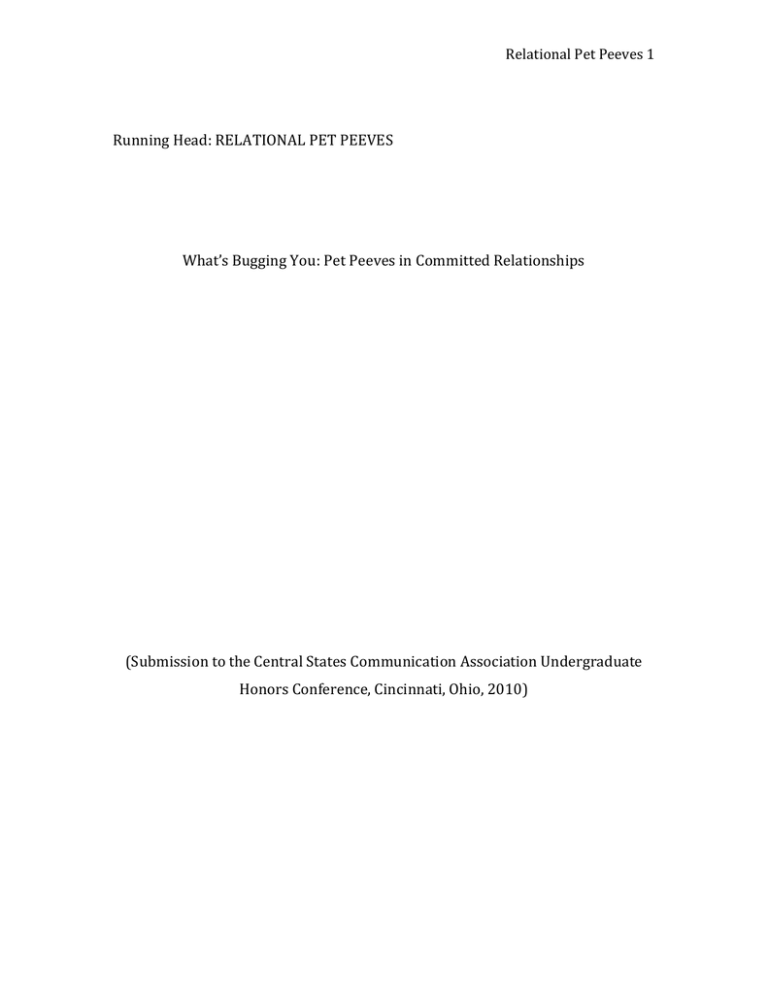A CSCA Ugrad Conference Submission.doc
advertisement

Relational Pet Peeves 1 Running Head: RELATIONAL PET PEEVES What’s Bugging You: Pet Peeves in Committed Relationships (Submission to the Central States Communication Association Undergraduate Honors Conference, Cincinnati, Ohio, 2010) Relational Pet Peeves 2 What’s Bugging You: Pet Peeves in Committed Relationships What’s bugging you? This is a common question that one might get on any given day of the week. What is really bugging us? Did someone just die in our lives and we are mourning them? Or did your significant other not put their toothbrush back in the toothbrush holder? Surprisingly enough the latter is probably truer. As a people we let everything get to us. We go by day to day and find something that annoys us terribly and often aren’t afraid to admit that it bothers us. These behaviors or social allergies are commonly known as pet peeves. I am conducting a research study on pet peeves in intimate relationships. I want to take a look at younger couples and really find out what they consider a pet peeve, why they have these pet peeves and will someone violating a pet peeve lead to the end of their relationship? These are really important questions to ask when trying to maintain a relationship. If you are unaware you are violating a pet peeve you may continue to hurt you significant other without any knowledge. Webster defines a pet peeve as a frequent subject of complaint. Is that how we define it? It is important to nail down the social definition because words or phrases mean different things to everyone. One person may interpret a frequent subject of complaint completely different from someone else. Another very important question to ask is whether or not the pet peeve violation will actually lead to the end of the relationship. What factors play into the destruction of the relationship? Is the violation of a pet peeve known or is the significant other violating it unconsciously. By taking two focus groups and analyzing their responses to these questions I hope to find the dark side of pet peeves. Relational Pet Peeves 3 Literature Review I wanted to research other peer-reviewed articles in order to find what has been researched in the area of pet peeves and where I can expand through my research. I also wanted to make sure to define or correctly identify my qualifications of my research. It is important that I not only find out what is out there about pet peeves, but also subjects concerning interpersonal relationships and romantic relationships. In this way I can greater understand what situations I may have to handle and if there are any deeper underlying factors that I might not have identified other wise. During review of articles there were some things that also need to be clarified. When I decided to study pet peeves and began research on that terminology I was quickly redirected to the term social allergies. A social allergen is a reaction of hypersensitive annoyance or disgust to a repeated behavior (Cunningham, Shamblen, and Barbee 2005). This definition turned my attention to correctly defining what a pet peeve actually is to our society. I wanted to know how everyone sees pet peeves. The article then went on to break down the various types of social allergens one might experience. Some examples were uncouth habits, inconsiderate behaviors and intrusive acts (Cunningham, Shamblen and Barbee 2005). These specific examples helped me in identifying themes throughout my research. Another topic in which I wanted to study was that of social penetration and how getting to know someone might be cause for more annoying behaviors. Social penetration theory deals with the development of social relationships from strangership and casual acquaintanceship to the formation of more intimate social bonds (Altman 1973). I wanted to know why deeper involvement with a person caused more pet peeve violations. In order to find this out I had to study Altman’s proposed process-oriented theory of the development, management and possible deterioration of social relationships. Relational Pet Peeves 4 When looking at the intimate relationships these phases are heightened because of the attraction and social pressure added. If we were just considering a normal relationship without intimacy factors are reduced because of lower expectations and less desirable benefits. Another aspect of social penetration theory is the disclosure of information. In the beginning stages of a relationship less information is divulged. That is why I thought it important to make sure these intimate relationships have lasted at least six months in order to have deeper relational penetration. With the level of intimacy increased more is shared and therefore more is known, and pet peeves are easier to identify. Instances of nonverbal communication are also important to consider. Most social allergies or pet peeves are tangible physical involvements, but often we can be irked by person’s nonverbal behaviors as well. Rolling of the eyes or the cold shoulder are strong nonverbals that often times annoy the person they are directed at. So when considering pet peeves we must include our unconscious nonverbal behaviors because of the implications this might have on the level of annoyance of the violated pet peeve. Interpersonal communication is necessary when in intimate relationships. Interpersonal communication entails multiple outcomes, and collectively these outcomes can be simultaneously constructive and destructive, functional and dysfunctional, and pleasurable and painful (Cupach and Spitzberg 2007). When studying pet peeves I am considering how much this will affect the future of relationships and how violation made lead to the ending of the relationships and how if interpersonal communication is not utilized effectively the relationship can deteriorate quickly. With this in mind I began my study and took a look into intimate relationships and how pet peeves are involved. In other words what’s bugging you? Relational Pet Peeves 5 Method I recruited 19 participants in a Midwestern University from Communication classes. Out of the 19 participants, 13 were female and 6 were males. The participants’ ranged in ages from 19 to 35 years old with and average age of 22.7 years old. The participants significant others ranged in ages from 20 to 32 years old with an average age of 23.5 years old. Out of the 19 participants 69% were not engaged, 31% were engaged and 0% were married. The minimum length of the relationship with the significant other was six months. The length of the relationships ranged from 6 months to 72 months. The average length of the relationship was 29.68 months. Upon retrieving all the demographic information from the participants they were then divided into two focus groups. These two focus groups where then asked a series of open-ended questions reflecting the goal of the researcher. Each session lasted no more than two hours and was very informal. The object of the focus group format was to generate conversation to allow for maximization of each question. I wanted to make sure nothing was left unsaid about pet peeves. Discussion After compiling the data and listening to the tape recording some very interesting themes were found in each of the focus groups. First the definition of pet peeves that each group agreed upon was slightly different from that of Webster’s and not as severe as the social allergies defined in my literature review. Second, most often verbal and nonverbal behaviors were not considered pet peeves. Most participants immediately considered only physical items involved to be pet peeves. Third, long distance relationships greatly affect the confrontation when a pet peeve has been violated. Finally, the participants believed that pet peeves would not lead to the end of a relationship because they Relational Pet Peeves 6 considered them more innocent or unintentional and most importantly not a flaw. My first question asked to my participants was what is your definition of a pet peeve? I wanted to make sure we all agreed upon a definition so we could refer back to it and really understand the implications the definition made throughout the study. Since I had two focus groups I had two definitions, but surprisingly they weren’t too different. The first group defined pet peeve as a significant annoying behavior. The implications of this definition make it seem that a pet peeve is not a trite unnoticed behavior and that it does have significance in the relationship. The second group defined pet peeve as a repetitive annoying behavior performed by humans. This last addition of “caused by humans” implies that pet peeve is something only humans can have and that inanimate objects cannot annoy someone. Now we have all fought with our VCR before but that is a man made object, so by this definition our pet peeve of electronics malfunctioning lies on the creator of the device not the machine itself. Also this definition lets us place blame. If there is no one around to blame for our annoyance the level of frustration dwindles because the object cannot feel and respond. With these definitions I can also infer that pet peeves require another human beings response. Without someone to receive the message of frustration the reaction is not validated. We as humans need to validate our emotions in order to be considered annoyed. After putting down an accepted concrete definition I simply wanted to find out what my participants considered a pet peeve. Thus began a very riveting conversation on how “I can’t stand wet popcorn and wet socks, there is just something about that I can’t stand.” The first reaction of most participants was to explain and divulge general pet peeves that they have with everyone no matter what. One participant was very adamant about not letting anyone drink from his or her cup, and if you did how they would then no longer drink from the Relational Pet Peeves 7 cup. After a round or two of addressing general pet peeves, I then asked them what pet peeves they have with their significant others. One participant responded with my significant other “doesn’t think I fart or poop.” This response begs the question of how people are viewed and why do we think that those actions don’t occur? Were we raised in a specific way that our pet peeves model our upbringing? If we were raised to clean our room and make our bed everyday does our significant other not doing that become a pet peeve of ours? After further questioning I found that most participants agreed that the way they were raised played a role in their pet peeves. One participant is a very tidy person and is with an unclean person. This violation by the significant other usually results in nagging and suggestive language by the participant that would lead to arguments. Another method used commonly by the participants was gunnysacking. Participants would often wait to confront their significant other until multiple pet peeves were violated, thus creating a big argument and completely blindsiding the significant other. This technique is popular in long distance relationships for the simple fact that when they are together they don’t want to fight. They only have a limited amount of time to spend together and they don’t want to ruin that time with arguing about little things. Another question follows, when they are able to spend more time together are they going to discover more about that person they don’t like? Will these pet peeves they were able to ignore before suddenly become more? I cannot answer this question but it does make you wonder if pet peeves can lead to the breakdown of a relationship. As I would further question about pet peeves I unveiled another theme. Women tend to have opposite opinions of men on certain pet peeves. For instance one of the male participants was expressing how his pet peeve of his significant other was how she always planned things. This participant saw this annoying because of his laid back nature and wanting to make plans as the day comes and not a week before hand. “I have no idea what I’m doing Friday, it’s Relational Pet Peeves 8 only Tuesday.” After saying this I looked at the female participants and could almost see them jumping out of their seat at him. Most of the women then agreed that the unplanned nature of their significant others was highly annoying to them. They wanted to have some idea of what they will be doing together this week. It was important to them, almost to the point of arguing right there and then in the interview. After discovering this I wanted to know how often do pet peeves violations happen because situations like he one stated before. My participants responded immediately. One of the participants significant other always wanted dishes out of the sink and immediately put away, but the participant proposed the question “the what do you have a sink for if not to hold dishes?” This query started a pet peeve disagreement almost immediately. Noticing that gender plays a role in pet peeve violation is very significant and often times when one violates a pet peeve, the offender in return has one of their pet peeves violated as well. Discussing pet peeves further with my groups I found that most participants were referring to physical things the significant other would do. For example they would refer to “leaving the box top on the cereal open.” They were not considering nonverbal behaviors. I see this as a major oversight because nothing upsets us more that someone rolling his or her eyes during a conversation. This may be a general statement but we most often don’t consider those nonverbal behaviors pet peeves. I on the other hand believe them to be extremely overlooked and extremely detrimental. Our true feelings are most often shown through our nonverbal behaviors. Body language speaks in volumes compared to the simple statement of “I’m fine, nothing’s wrong.” We know this statement to not be true because their facial expression and slumped shoulder say otherwise. After posing this question of what are some nonverbal pet peeves, participants quickly responded. “I can’t stand it when he shrugs his shoulders to answer a question.” These responses often contribute to a greater response from the recipient. Also we are sometimes unconscious of the Relational Pet Peeves 9 nonverbal behavior. We could easily roll our eyes and not even realize we did it. This oversight on nonverbal behaviors is a serious one. without the realization of these we might go on violating them unconsciously and then one day when our partner breaks up with us for no apparent reason we sit and wonder. This of course brings me to my previously mentioned question of whether or not pet peeves being violated can lead to the end of the relationship. When I initially asked the question if pet peeves being violated would lead to the ending of a relationship I was immediately met with a resounding no, but after further interrogation I discovered that there are levels of pet peeves. Most of my participants considered pet peeves as little annoyances that they could deal with, but then I reminded them of their definition stating that it was a significant repetitive annoying behavior. They backtracked a little and then explained that there are various degrees of a pet peeve. After continual violation of a pet peeve it no longer is considered a pet peeve, but is now a flaw. This I very interesting because it shows the seriousness at which people considers a pet peeve. Whether they no longer consider it a pet peeve is irrelevant, the fact is that it started as one and escaladed to more. The initial violation was seen as nothing, but after repetitive annoyance it becomes a flaw. If you reread my previous sentence you will see that their definition of a pet peeve is involved. My mind can’t help but ask why do we consider pet peeves to be no big deal? They seemingly are the roots of what might eventually be found a personality flaw. Another implication that might be considered is the mood of the person when the pet peeve is violated. Is their mood dependent on the level in which they take offense? I asked my focus group and all agreed. Emotions are a huge part. My next question then is, are emotions the reason for pet peeves moving from something little to a considerable flaw? Is leaving the toilet seat up a relationship destroyer because you were fired that day? It is important to take into account why that person reacts to the violated pet peeve. I would hope that the person be in control of there emotions and be able to respond appropriately, Relational Pet Peeves 10 but lets face it, there is no way that is possible. We are human and we are looking to lay blame on another human, which according to this study is a very involved part of the pet peeve definition. This question was also based on gender, most women would react immediately when in a heightened emotional state, on the contrary men stated that they would wait to tell their significant other they violated a pet peeve after they were both calm. Now this is probably not true in all cases but for this study most men admitted that they would try to tell their significant other about their pet peeve violation after the situation has passed. The role gender plays is important to determining the level of the pet peeve violation. Do they consider it a flaw or just small little pet peeve? Will this escalation of the pet peeve end the relationship? Study Limitations and Future Directions You can’t go through an entire study without realizing that there are limitations to your study and areas on which you can expand in the future. My study was very limited in the sample size. I only had 19 participants to try to cover the topic of pet peeves. Also all of my participants had taken upper level communication classes, which in way can train them to respond in ways others might not be aware of. Another critique I have is the gender skew. Most of my participants were female. This skew allowed for a very limited glance on how men react specifically to pet peeves. Without more study on the male perspective my study shows limited data. My study was also geared to college students. I believe this is a limitation because of the inexperience in relationships and the possible affect age and lifestyle has on their perceptions. An older person might not see it the same way as a group of college students do. Overall I started with limitations, but have many avenues now on which to expand. To further my research in the future would be very rewarding. Many questions were raised while conducting the experiment. For instance an entire Relational Pet Peeves 11 study could be done on pet peeves in long distance relationships and how the interactions differ from local relationships. Another avenue you could pursue is a specific study on nonverbal behaviors as pet peeves in intimate relationships. I am happy that my research generated a greater interest in me to conduct more research study in order to expand my knowledge and understanding of pet peeves. Overall the study in my eyes was a success. I unearthed a social definition of what a pet peeve actually is and how if a pet peeve is continually violated that in can escalade into a flaw. I discovered that nonverbal behaviors are often not overlooked as pet peeves. Also how gender plays a huge role in the intensity that is placed on the pet peeve violation. With all this and more I am satisfied with my research and look forward to expanding it in the future. Relational Pet Peeves 12 References Altman, I., & Taylor, D. A. (1973). Social penetration: The development of interpersonal relationships . New York: Holt, Rinehart, & Winston. Cunningham, M. R., Ault, L., & Shamblen, S. R. (2001, July). From impression management to social allergy: Romantic deflation and the emergence of aversive behaviors . Paper presented at the Conference of the International Network on Personal Relationships, Prescott, AZ. Ekman, P., Friesen, W. V., Angier, N., Daly, J. A., Hogg, E., Sacks, D. et al. (1999). Kinesic cues: The body, eyes, and face . In L. K. Guerrero, J. A. DeVito (Eds.) The nonverbal communication reader: Classic and contemporary readings (2nd ed., pp. 48– 89). Prospect Heights, IL: Waveland Press. Knapp, M. L., & Vangelisti, A. (1996). Interpersonal communication and human relationships (3rd ed.). Boston: Allyn & Bacon. Shamblen, S. R. (2004). My partner wasn’t so disgusting when we first started dating; what happened? An exploration of change process in close relationships . Unpublished doctoral dissertation, University of Louisville, Louisville, KY. Spitzberg, B.H., & Cupach, W.R. (Ed.). (2007). The Dark side of interpersonal communication. Mahwah, New Jersey: Lawrence Erlbaum Associates, Inc..



